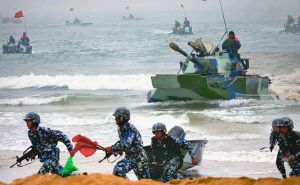China has responded to Taiwanese President Tsai Ing-wen’s visit to the US and meetings with senior American lawmakers with massive air and naval drills.
This week, multiple media outlets reported on China’s extensive air and naval drills off Taiwan, mirroring the militaristic precedent set by then-US Speaker of the House of Representatives Nancy Pelosi’s visit to Taiwan last year.
China’s stated goal for the exercise, codenamed “Joint Sharp Sword,” is to test the People’s Liberation Army’s (PLA) capability to control the sea, air and information space in and around Taiwan, which Chinese President Xi Jinping has vowed to “reunify” with the mainland.
On April 9, Taiwan’s defense ministry said that it had spotted 70 Chinese aircraft around Taiwan, including Su-30 fighters, H-6 bombers and 11 ships including China’s Shandong aircraft carrier.
China has simulated “precision attacks” on critical targets in Taiwan such as runways and military logistics facilities, with China’s Eastern Theater Command releasing a video showing missiles fired from sea, air, and land into Taiwan, with two missiles exploding as they hit their targets.
This month, Reuters reported that China’s Fujian maritime safety administration launched a three-day “special operation” alongside the Joint Sharp Sword drills in the northern and central parts of the Taiwan Strait that includes “on-site inspections” of cargo ships and construction vessels.
Reuters mentioned that Taiwan’s Transport Ministry’s Maritime and Ports Bureau lodged in response a strong protest, instructed relevant shipping operators to refuse such orders and to notify Taiwan’s coast guard to render assistance if they are stopped for inspections.
Bradley Martin and other writers mention in a 2022 RAND report that while China has the air and naval power to impose a blockade of Taiwan, using the PLA coveys the message that China is invading another country, in stark contrast to its narrative framing the Taiwan issue as an internal affair. Officially, Beijing considers Taiwan a renegade province.

Martin and others note that the China Coast Guard’s (CCG) substantial fleet size of 130 large patrol ships, 70 fast patrol combatants and 400 coastal patrol craft is larger than many navies in East Asia.
They also note that these ships are increasingly well-armed and could be used to interdict ships in a quarantine scenario, with China’s air and naval forces on standby to deter and respond against escalation by Taiwan, the US and its allies.
Willian Yang mentions in a DW video this month that China puts emphasis on displaying its airpower and rocket forces, as these two took center stage during China’s show of force last year around Taiwan.
Yang notes that China’s intensified incursions into Taiwan’s airspace aim to play up the risk of unintended encounters with dangerous consequences.
Asia Times noted last May that such a modus might be in line with China’s aerial attrition strategy, wherein China aims to inflict losses against Taiwan by forcing it to sustain a tempo of operations beyond its capabilities.
That, in turn, could result in miscalculation and unintended escalation due to pilot and ground crew fatigue, aircraft losses via wear and tear, strained logistics and maintenance, and accidents.
Yang also says the Taiwanese government has been monitoring China’s rocket force, with its hypersonic missiles of particular concern. Asia Times noted in February that China fired DF-17 missiles during its show of force in the Taiwan Strait last August, demonstrating China’s ability to box in Taiwan with long-range precision fires on top of an air and naval blockade.
Asia Times noted last August that China’s repeated exercises such as these may be an attempt to normalize periodic military drills around Taiwan, with each iteration growing in scale and intensity.
This squeeze-and-relax approach is characterized by the assumption that time is on China’s side and it need not overextend to reunify Taiwan, meaning any massive Chinese exercise in the Taiwan Strait could already be the real thing – a complete and indefinite blockade to starve Taiwan into submission.
There are different perspectives on what a decisive Chinese operation against Taiwan would entail.

While China may attempt an all-out amphibious assault, with its prepositioning of forces masquerading as preparations for military exercises, Asia Times noted this January that this approach would probably end in devastating casualties for China and a Pyrrhic victory for the US and its allies, with massive costs in ships, aircraft and lives for all parties involved.
That’s in part because Taiwan has adopted a porcupine strategy built on small, numerous and survivable assets including long-range missiles, armed drones, and anti-submarine stealth corvettes designed to ride out the initial wave of Chinese air and missile attacks and continue operating under a blockade.
China could also attempt a decapitation strike, similar to Russia’s failed attempt to seize Kiev last year. The Telegraph notes in a video this month that such a decapitation attempt against Taiwan’s leadership would likely begin with massive cyberattacks to paralyze Taiwan’s decision-making bodies, followed by a lightning strike to get on the main island all within 48 hours to avoid international reaction to the de facto new regime in Taiwan.
The Telegraph report notes that China may have learned a lesson from Russia’s slow operational tempo that has allowed international support for Ukraine to materialize and entrench. However, there may be no “Ukraine model” for Taiwan since China can blockade the self-governing island for weeks or months to prevent resupply.
Seizing one of Taiwan’s frontline islands is also an option for China. These islands, such as Kinmen and Matsu, are challenging to defend, presenting tempting targets to demoralize the Taiwanese government.
However, Asia Times noted in July 2022 that these frontline islands are relatively hard targets as they play a critical role in Taiwan’s strategy of deterrence through protraction, with Kinmen and Matsu boasting extensive fortifications, heavy firepower and a substantial garrison to a layered island defense against a potential Chinese invasion.

